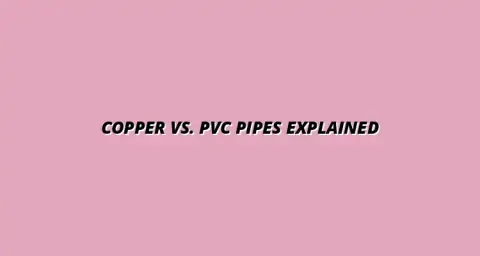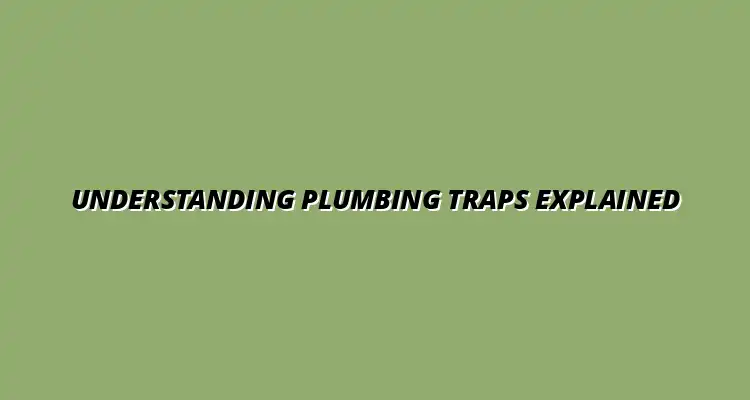
- Plumbing Basics
- Feb 17
2024-12-28
When we talk about plumbing systems, one term that comes up often is *plumbing traps*. But what exactly are they? A plumbing trap is a device designed to hold a small amount of water in its curve, creating a barrier that prevents harmful sewer gases from entering your home. Understanding these traps is essential for anyone looking to maintain their plumbing system effectively. For a more comprehensive understanding of residential plumbing systems, check out this helpful guide on understanding residential plumbing systems.
In essence, plumbing traps play a critical role in your home’s plumbing. They not only keep unpleasant odors at bay but also help prevent sewer gases from leaking into the living area. The design of these traps is quite simple yet vital for the overall functionality of plumbing systems.
Plumbing traps are designed to catch debris and keep it from entering the sewer line while allowing wastewater to flow freely. The most common type of trap is the *P-trap*, which is shaped like the letter "P" and is typically found beneath sinks. Other shapes, like the *S-trap*, also serve similar purposes in different parts of the plumbing system. If you're experiencing issues with your kitchen sink, learning about kitchen plumbing problems and solutions can be very beneficial.
These devices are crucial in maintaining a healthy and functional plumbing system. Without them, toxic gases from the sewer could seep into our homes, posing health risks. Therefore, understanding the different types of traps and their functions is essential for anyone interested in plumbing!
The primary function of a plumbing trap is to create a water seal that blocks sewer gases. This barrier is essential for maintaining a healthy indoor environment. If the water seal dries out, it can lead to unpleasant odors and potential health hazards.
Additionally, plumbing traps serve other important functions. They help to trap debris, preventing it from causing blockages in the plumbing system. This is especially important in kitchen sinks, where food particles can easily clog pipes. Learning quick ways to unblock a sink can be a valuable skill for homeowners.
There are several types of plumbing traps, each designed for specific applications. Knowing the differences can help you select the right trap for your needs. Most homeowners will encounter two main types: the *P-trap* and the *S-trap*, but others exist as well.
Choosing the right plumbing trap is essential for a well-functioning home system. Each type has unique characteristics that make it suitable for particular fixtures or spaces. For instance, the P-trap is ideal for sinks, while the S-trap is commonly used in toilets.
Understanding the various types of plumbing traps is essential for selecting the right one for your home. The *P-trap* is widely recognized for its effectiveness under sinks. It holds water in its curved design, providing a barrier against foul odors.
On the other hand, the *S-trap* is frequently found in toilets, designed to handle waste efficiently. Other varieties, like drum traps and bottle traps, may be used in specific scenarios. A basic understanding of common plumbing terms can be helpful; this guide on plumbing terms simplified for beginners is a good starting point. Each trap has its advantages, and it's essential to consider where it will be used.
Choosing the right plumbing trap is crucial for ensuring the smooth operation of your plumbing system. Consider factors like the type of fixture and the space available. For instance, a P-trap works wonders under a sink, while an S-trap is better suited for a toilet.
When selecting a trap, also think about the potential for clogs. If your kitchen sink often gets food debris, opting for a trap that can catch larger particles might be wise. Always ensure that the trap you choose meets local building codes and standards! Knowing how to fix a leaky faucet is another valuable plumbing skill.
A missing or damaged plumbing trap can lead to some serious issues in your home. Without a trap, wastewater can flow freely and could potentially lead to unpleasant odors and harmful gases entering your living space. Moreover, the absence of a trap can increase the risk of clogs and plumbing backups, creating a messy and inconvenient situation. In case of emergencies, knowing how to find a plumber can be essential.
Additionally, if a trap is damaged, it may cause leaks that can result in water damage over time. This can create mold growth, which is another health concern for your family. In short, it's crucial to have a functioning plumbing trap to maintain a healthy and safe home environment.
While plumbing traps are essential for various fixtures, they cannot be installed just anywhere. Each fixture in your home has specific requirements for where traps can be placed, depending on the layout of your plumbing system. For instance, traps must be located below the fixture they serve to function correctly.
Moreover, the distance between the trap and the fixture is also important; if it's too far, it may not maintain the necessary water seal. Therefore, understanding the best location for a plumbing trap is key to ensuring it works effectively.
Maintaining your plumbing traps is vital for their longevity and effectiveness. Regular cleaning can help prevent buildup, which can lead to clogs and other issues. One simple method is to flush the trap with hot water periodically to remove debris and grease.
In addition to regular cleaning, you should also inspect your traps for any signs of damage or wear. Look for leaks or cracks that may indicate a problem. By addressing these issues early, you can avoid costly repairs down the road. Regular maintenance of your water heater is also important; here's a guide on maintaining your water heater efficiently.
Sometimes, plumbing trap issues may be too complex to handle on your own. If you notice persistent problems such as slow drainage or frequent clogs, it may be time to call a professional. They have the expertise and tools necessary to diagnose and fix issues that are not easily seen or accessed.
Additionally, if you find that your traps are leaking or if you suspect a more significant plumbing problem, professional help is recommended. It's better to address these concerns sooner rather than later to avoid more extensive damage and costly repairs.
In summary, plumbing traps play a critical role in maintaining a safe and functional home plumbing system. They prevent odors and gases from entering your living space while also ensuring that wastewater flows smoothly. Understanding their functions can help homeowners appreciate their importance.
Moreover, keeping your plumbing traps in good shape can save you time and money on repairs. Regular maintenance and quick responses to issues will enhance the performance of these essential components, contributing to a healthy home environment.
Now that you know the importance of plumbing traps, proactive maintenance is crucial for every homeowner. Regular inspections and cleaning can go a long way in preventing bigger issues. Taking these simple steps can help ensure your plumbing system remains in top shape!
It’s essential to stay informed about your plumbing system’s health and act promptly when issues arise. Whether it’s a DIY approach or calling in a professional, prioritizing plumbing maintenance will lead to a healthier and more efficient home. So, don't wait—start checking those traps today!
